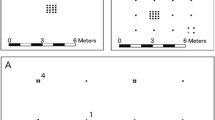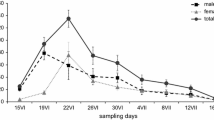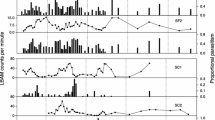Abstract
Mechanisms responsible for population stability in relation to resource availability were studied in an introduced herbivorous lady beetle,Epilachna niponica. The introduced population was relatively constant over a seven-year study period. Egg density was related to the variation in host-plant abundance in different years, and was highly stabilized during the period from reproductive adult to egg stage. Two density-dependent processes were identified in the reproductive season: (1) density-dependent reduction in fecundity and (2) density-dependent increase in female mortality and/or emigration, all of which operated early in the season. As a result, temporal variability in cumulative egg density was greatly reduced by mid-May, by which time approximately40% of total eggs were laid. A field cage experiment demonstrated that egg-laying of individual females was largely limited by resource availability even at low levels of leaf herbivory. Since movement activity of ovipositing females increased in a density-dependent manner, inter-plant movement is more likely to cause density-dependent reduction in fecundity and female loss, due to enhanced energy expendiditure. The introduced population was less stable than the source population, probably because of decreased inter-plant movement of females and the unlikelihood of egg resorption, both of which contribute significantly to the temporal stability ofE. niponica population densities.
Similar content being viewed by others
References
Cappuccino, N. (1992) The nature of population stability inEurosta solidaginis, a nonoutbreaking herbivore of goldenrod.Ecology 73: 1792–1801.
Connell, J. H. and W. P. Sousa (1983) On the evidence needed to judge ecological stability or persistence.American Naturalist 121: 789–824.
Dempster, J. P. (1971) The population ecology of the cinnabar moth,Tyria jacobaeae L. (Lepidoptera, Arctiidae).Oecologia 7: 26–67.
Dempster, J. P. (1975)Animal population ecology. Academic Press, London.
Dempster, J. P. (1982) The ecology of the cinnabar moth,Tyria jacobaeae L. (Lepidoptera: Arctiidae).Advances in Ecological Research 12: 1–36.
Dempster, J. P. (1983) The natural control of populations of butterflies and moths.Biological Review 58: 461–481.
Dempster, J.P. and E. Pollard (1981) Fluctuations in resource availability and insect populations.Oecologia 50: 412–416.
Gaston, K. J. and B. H. McArdle (1994) The temporal variability of animal abundances: measures, methods and patterns.Philosophical Transactions of the Royal Society of London Series B 345: 335–358.
Hairston, N. G., F. E. Smith and L. B. Slobodkin (1960) Community structure, population control, and competition.American Naturalist 94: 421–425.
Harrison, S. and N. Cappuccino (1995) Using density-manipulation experiments to study population regulation, pp. 131–147.In N. Cappuccino and P. W. Price (eds.)Population dynamics: new approaches and synthesis. Academic Press, San Diego.
Hassell, M. P., J. H. Lawton and R. M. May (1976) Patterns of dynamical behaviour in single-species populations.Journal of Animal Ecology 45: 471–486.
Hunter, M. D., T. Ohgushi and P. W. Price (eds.) (1992)Effects of resource distribution on animal-plant interactions. Academic Press, San Diego.
Jolly, G. M. (1965) Explicit estimates from capture-recapture data with both death and immigration —stochastic model.Biometrika 52: 225–247.
Kareiva, P. (1982) Experimental and mathematical analysis of herbivore movement: quantifying the influence of plant spacing and quality on foraging discrimination.Ecological Monographs 52: 261–282.
Lawton, J. H. and D. R. J. Strong (1981) Community patterns and competition in folivorous insects.American Naturalist 118: 317–338.
Mattson, W. J. (1980) Cone resources and the ecology of the red pine cone beetle,Conophthorus resinosae (Coleoptera: Scolytidae).Annals of the Entomological Society of America 73: 390–396.
Nakamura, K. and T. Ohgushi (1979) Studies on the population dynamics of a thistle-feeding lady beetle,Henosepilachna pustulosa (Kono) in a cool temperate climax forest. I. The estimation of adult population parameters by the marking, release and recapture method.Researches on Population Ecology 20: 297–314.
Nakamura, K. and T. Ohgushi (1981) Studies on the population dynamics of a thistle-feeding lady beetle,Henosepilachna pustulosa (Kono) in a cool temperate climax forest. II. Life tables, key-factor analysis, and detection of regulatory mechanisms.Researches on Population Ecology 23: 210–231.
Nakamura, K. and T. Ohgushi (1983) Studies on the population dynamics of a thistle-feeding lady beetle,Henosepilachna pustulosa (Kono) in a cool temperate climax forest. III. The spatial dynamics and the analysis of dispersal behaviour.Researches on Population Ecology 25: 1–19.
Ohgushi, T. (1992) Resource limitation on insect herbivore populations, pp. 199–241.In M. D. Hunter, T. Ohgushi and P. W. Price (eds.)Effects of resource distribution on animal-plant interactions. Academic Press, San Diego.
Ohgushi, T. (1995) Adaptive behavior produces stability in herbivorous lady beetle populations, pp. 303–319.In N. Cappuccino and P. W. Price (eds.)Population dynamics: new approaches and synthesis. Academic Press, San Diego.
Ohgushi, T. (1996) A reproductive tradeoff in an herbivorous lady beetle: egg resorption and female survival.Oecologia 106: 345–351.
Ohgushi, T. and H. Sawada (1981) The dynamics of natural populations of a phytophagous lady beetle,Henosepilachna pustulosa under different habitat conditions I. Comparison of adult population parameters among local populations in relation to habitat stability.Researches on Population Ecology 23: 94–115.
Ohgushi, T. and H. Sawada (1985) Population equilibrium with respect to available food resource and its behavioural basis in an herbivorous lady beetle,Henosepilachna niponica.journal of Animal Ecology 54: 781–796.
Ohgushi, T. and H. Sawada (1995) Demographic attributes of an introduced herbivorous lady beetle.Researches on Population Ecology 37: 29–36.
Ohgushi, T. and H. Sawada (1997) A shift toward early reproduction in an introduced herbivorous ladybird.Ecological Entomology 22: 90–96.
Pimm, S. L. (1991)The balance of nature?: ecological issues in the conservation of species and communities. The University of Chicago Press, Chicago.
Podoler, H. and D. Rogers (1975) A new method for the identification of key factors from life-table data.Journal of Animal Ecology 44: 85–114.
Preszler, R. W. and P. W. Price (1988) Host quality and sawfly populations: a new approach to life table analysis.Ecology 69: 2012–2020.
Price, P. W. (1992) Plant resources as the mechanistic basis for insect herbivore population dynamics, pp. 139–173.In M. D. Hunter, T. Ohgushi and P. W. Price (eds.)Resource distribution and animal-plant interactions. Academic Press, San Diego.
Redfearn, A. and S. L. Pimm (1988) Population variability and polyphagy in herbivorous insect communities.Ecological Monographs 58: 39–55.
Romstöck-Völkl, M. (1990) Population dynamics ofTephritis conura Loew (Diptera: Tephritidae): determinants of density from three trophic levels.Journal of Animal Ecology 59: 251–268.
Sawada, H. and T. Ohgushi (1994) An introduction experiment of an herbivorous lady beetle: characteristics of the adult population.Researches on Population Ecology 36: 29–36.
Schoener, T. W. (1985) Are lizard population sizes unusually constant through time?American Naturalist 126: 633–641.
Seber, G. A. F. (1973)The estimation of animal abundance and related parameters. Griffin, London.
Southwood, T. R. E. and W. F. Jepson (1962) Studies on the populations ofOscinella frit L. (Dipt: Chloropidae) in the oat crop.Journal of Animal Ecology 31: 481–495.
Stiling, P. (1988) Density-dependent processes and key factors in insect populations.Journal of Animal Ecology 57: 581–593.
Varley, G. C., G. R. Gradwell and M. P. Hassell (1973)Insect population ecology: an analytical approach. Blackwell Scientific Publications, Oxford.
Wiens, J. A. (1984) Resource systems, populations, and communities, pp. 397–436.In P. W. Price, C. N. Slobodchikoff and W. S. Gaud (eds.)A new ecology. John Wiley & Sons, New York.
Wolda, H. (1978) Fluctuations in abundance of tropical insects.American Naturalist 112: 1017–1045.
Author information
Authors and Affiliations
Corresponding author
Rights and permissions
About this article
Cite this article
Ohgushi, T., Sawada, H. Population stability in relation to resource availability in an introduced population of an herbivorous lady beetle. Res Popul Ecol 39, 37–45 (1997). https://doi.org/10.1007/BF02765248
Received:
Accepted:
Issue Date:
DOI: https://doi.org/10.1007/BF02765248




